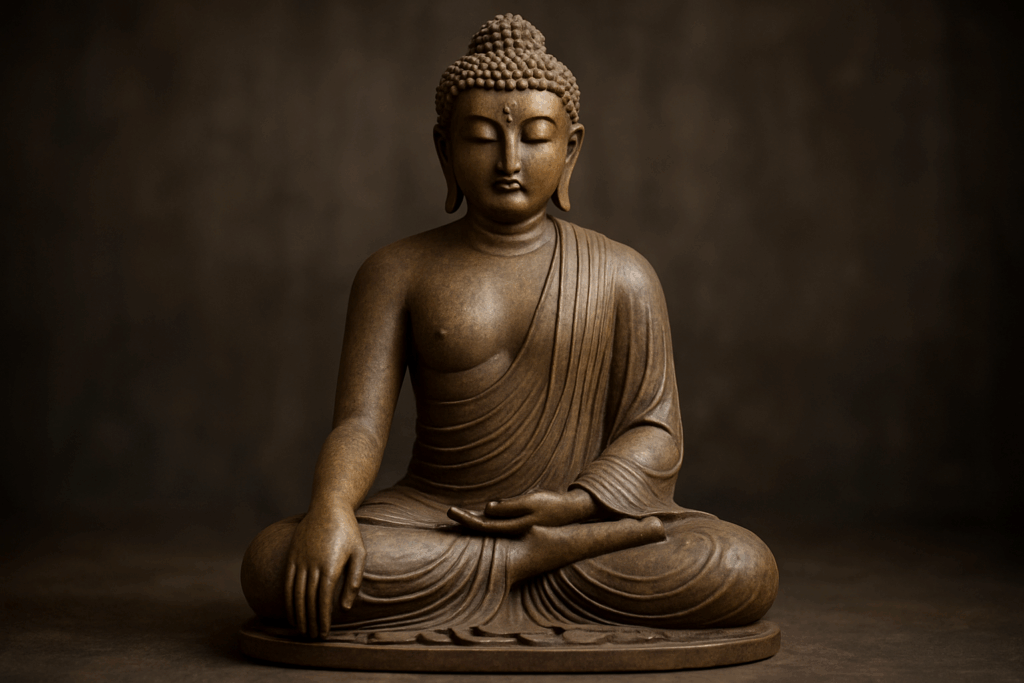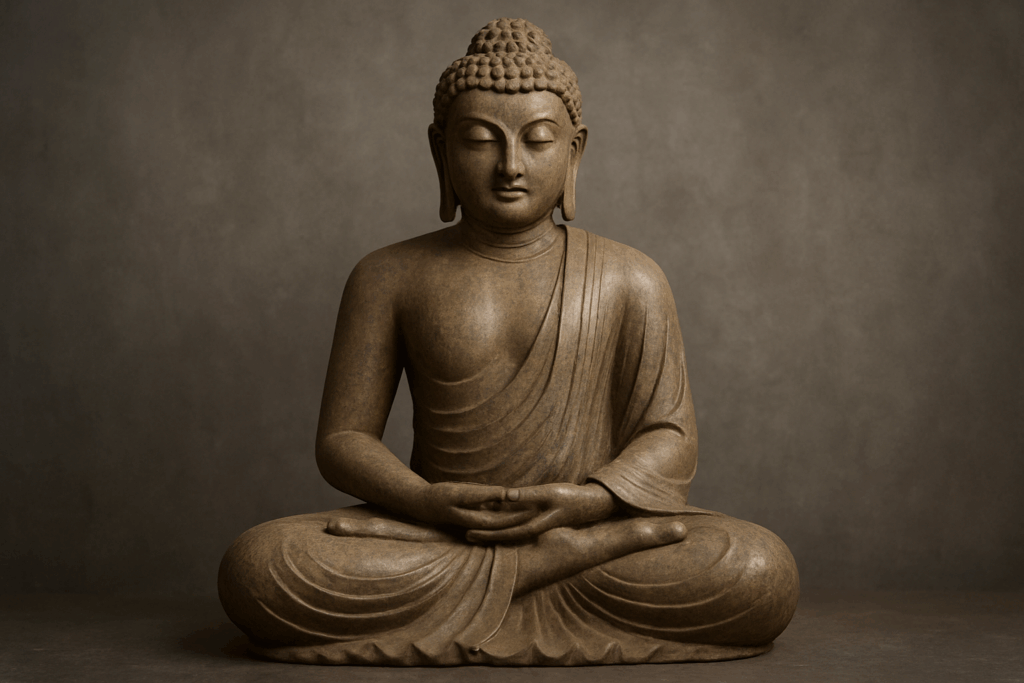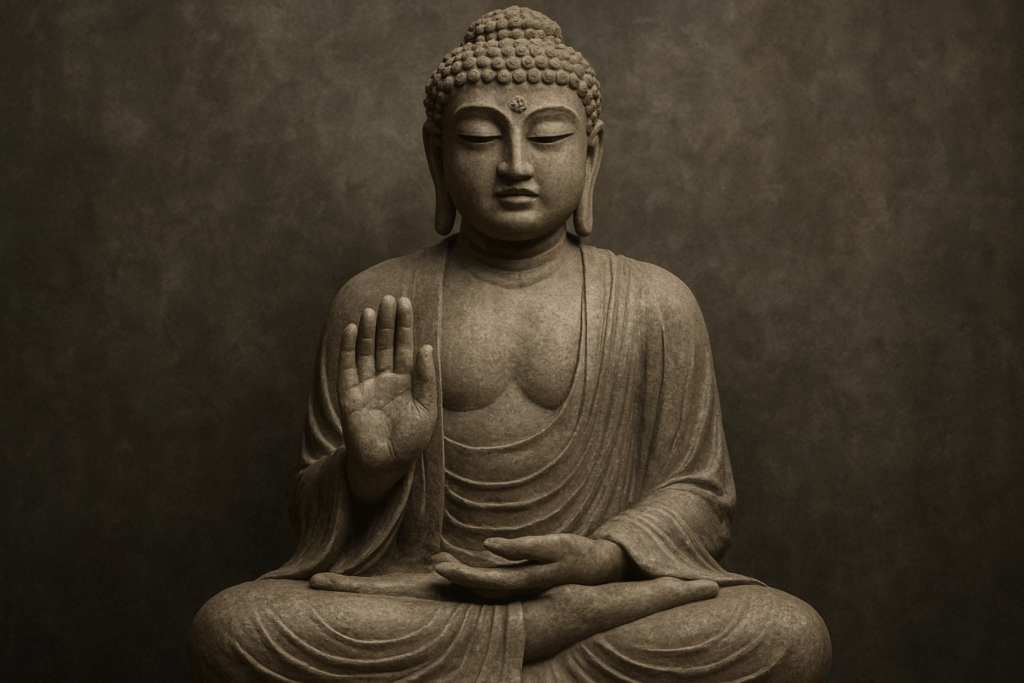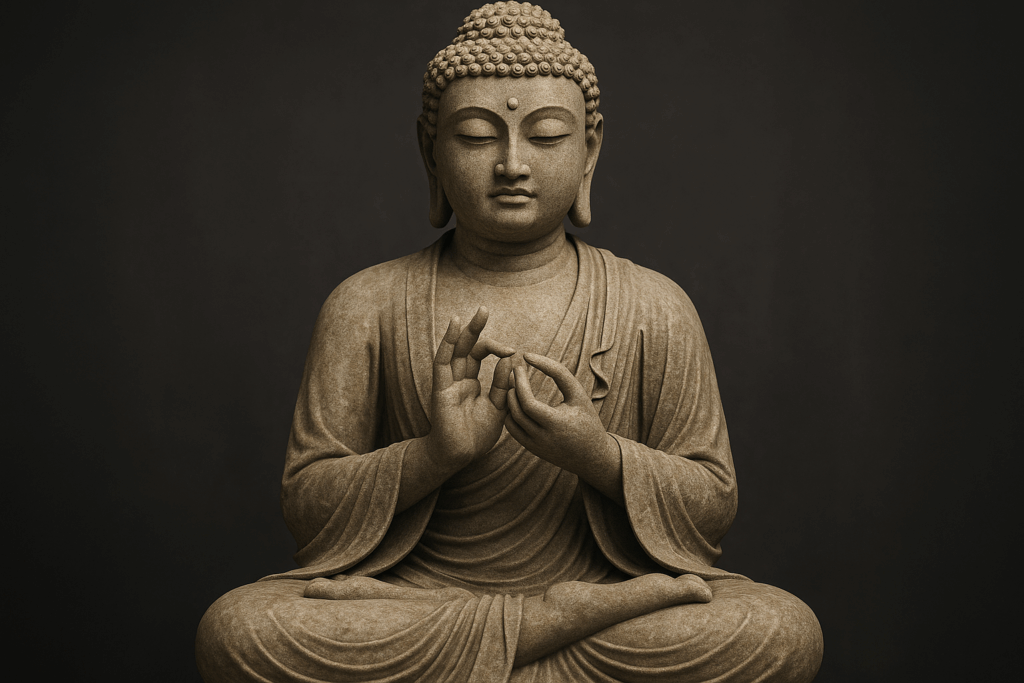🧘 Buddha Images & Their Meaning
What the Buddha is telling you – without words
Statues and images of the Buddha are found in nearly every temple – sitting, standing, lying down. Often visitors admire the calm and beauty of these figures, but don’t realize: every detail is full of meaning. The hands, the face, the posture – they all communicate something about the Buddha’s life, teachings, and state of mind.
Once you learn the visual language, you stop seeing “just a statue” – and start reading a message.
🤲 Mudrās – The Buddha’s Hand Gestures
The Buddha never needed to speak to be understood. His hands alone tell stories.
Here are some of the most common mudrās (ritual hand gestures) you’ll see:
| Mudrā | Gesture | Meaning |
|---|---|---|
| Bhumisparsha (Earth-touching) | Right hand touches the ground | “Calling the Earth to witness” – moment of enlightenment. Learn more |
| Dhyāna (Meditation) | Both hands in lap, palms up | Deep concentration and inner peace. Lern more |
| Abhaya (Fearlessness) | Right hand raised, palm forward | Protection, reassurance – “Do not fear” Learn more |
| Dharmachakra (Turning the Wheel) | Hands at chest, fingers forming a circle | Teaching the Dharma – first sermon. Learn more |
| Varada (Giving) | Palm open, pointing down | Compassion, generosity. Learn more |
Tip: When you enter a temple, observe the hands first.
The Buddha is speaking without speaking.
👁️ Facial Features & Posture
Each part of the Buddha’s image conveys a deeper idea:
- Eyes: Half-closed in meditation – awareness turned inward
- Mouth: Slight smile – calm joy, not excitement
- Hair: Curled tightly in snailshell spirals – symbolic of renunciation
- Ushnisha (topknot): A cranial bump – symbol of expanded wisdom
- Urna: A small dot between the eyebrows – spiritual insight
- Elongated earlobes: From princely jewelry once worn – now empty, symbol of letting go
- Bare feet: Grounded, present, human
📐 Postures – What is the Buddha doing?
You’ll see Buddha statues in different body positions. These usually relate to a moment in his life:
| Posture | Meaning |
|---|---|
| Seated (Lotus position) | Meditation, enlightenment |
| Standing | Teaching, ready to act |
| Walking | Spreading the Dharma, movement |
| Reclining | Final nirvana (parinirvana), passing away |
👀 What to look for in temples:
- Which mudrā is shown?
- Are there multiple Buddhas with different gestures?
- Is the Buddha surrounded by disciples, animals, or mythic figures?
Sometimes you’ll also see multiple heads or arms (especially in Mahayana/Vajrayana art) – these are symbolic, not literal, showing qualities like omniscience or compassion.
🙏 How to behave:
- Always approach with respect – this is not decoration, but veneration
- Never point your feet at a Buddha image
- Avoid turning your back directly toward the statue when walking away
- Don’t climb on statues or pose in silly ways for photos
You don’t need to be Buddhist to feel reverence.
Just be quiet, present – and open.
“A Buddha statue is not just art.
It’s a map of the mind.
Once you know how to read it, it can guide you – even in silence.”
🤲 Mudrās – The Buddha’s Hand Gestures in detail
🌍 Bhumisparsha Mudrā
The Earth as witness – the moment of awakening

Among all the hand gestures (mudrās) of the Buddha, the Bhumisparsha – or Earth-touching mudrā – is perhaps the most iconic and profound. You will see it in countless temples across Southeast Asia, most often in seated Buddha statues, with one hand resting gently on the knee, fingers extended toward the ground.
It marks the precise moment of the Buddha’s enlightenment.
✋ What does the gesture show?
- The left hand rests in the lap, palm upward – symbolizing meditation and inner stillness.
- The right hand reaches down over the knee, the fingertips touching the earth.
This is not a casual pose. It is a powerful moment in spiritual history.
🕉️ What does it mean?
The gesture tells the story of Siddhartha Gautama sitting beneath the Bodhi tree, vowing not to rise until he understood the cause of suffering. As he approached full realization, Māra – the tempter or embodiment of illusion – challenged his right to awaken.
Siddhartha reached down and touched the Earth, calling her to witness his lifetimes of practice and virtue.
And the Earth responded with thunder – affirming his truth. Māra fled. Siddhartha became the Buddha.
🧘 Symbolism of the Earth-touching gesture
- Steadfastness: Rooted like a mountain, unshaken by fear or illusion
- Integration: Merging body, mind, and world – no separation
- Humility: The Buddha doesn’t claim enlightenment – he lets the Earth speak for him
- Truth made visible: Enlightenment is not an escape, but a return to what is
This mudrā expresses the non-verbal power of truth: quiet, grounded, and unstoppable.
🛕 Where will you see it?
- Common in Thailand, Laos, Myanmar, and Cambodia
- Often used for the main Buddha statue in a temple hall
- Usually paired with an austere, serene facial expression
- May be surrounded by relief carvings of the Māra scene (elephants, armies, daughters)
👀 What to look for:
- Is the Buddha seated in full lotus? (symbolizing spiritual perfection)
- Do the fingers gently touch the base, or dig into it with power?
- Are there carvings or paintings of earth spirits or goddesses?
- Is this statue treated with special reverence, offerings, or gold leaf?
🙏 How to reflect:
- When you see this mudrā, pause and ground yourself
- It is a call to stand firm in truth – not through struggle, but presence
- Remember: The Earth sees you. The Earth supports you.
“The Buddha didn’t fight illusion.
He simply touched the Earth – and the truth was enough.”
🧘 Dhyāna Mudrā
The stillness at the heart of all things

The Dhyāna Mudrā – also known as the Meditation Gesture – is one of the most peaceful and introspective poses found in Buddhist iconography. It appears in statues of the Buddha seated in serene concentration, hands resting gently in the lap, forming a perfect oval of calm.
This gesture symbolizes not just meditation as a technique – but meditation as the path, the method, and the goal.
✋ What does the gesture look like?
- Both hands lie in the lap, with palms facing upward.
- The right hand rests on top of the left, symbolizing mental clarity over physical stability.
- The thumbs lightly touch at the tips, forming a triangle or oval, representing balance and unity.
This triangle also mirrors the shape of a lotus flower, long associated with spiritual growth.
🧘 What does it mean?
The Dhyāna Mudrā expresses deep, undisturbed meditation – the moment when the mind turns inward and rests in awareness. It is the gesture of the Buddha before and during his enlightenment, when he sat beneath the Bodhi tree.
In this moment:
- The senses retreat
- Thought slows
- The illusion of self dissolves
It is not an escape from the world – it is the act of sitting within it, fully awake.
🌕 Symbolism of the gesture
- Inner stillness: The hands are unmoving, stable, silent
- Union of wisdom and method: Two hands, one circle
- Perfection of concentration: The base from which insight arises
- Empty fullness: The mind becomes spacious, like the open sky
In Zen Buddhism, this gesture is central to zazen – seated meditation. In Theravāda and Mahayāna iconography, it appears when the Buddha is shown at rest, in retreat, or in equanimity.
🛕 Where will you see it?
- Very common in Buddha statues in Thailand, Sri Lanka, Japan, China
- Usually shown with the Buddha in lotus position, eyes half-closed
- May be found in forest temples or meditation halls
- Sometimes paired with closed eyelids and plain robes, to emphasize simplicity
👀 What to observe:
- Is the triangle formed by the thumbs perfect and gentle?
- Are there other figures around the Buddha (disciples, animals, symbols of nature)?
- What mood does the statue create? Can you feel the stillness?
- Is incense offered? Are people meditating nearby?
🙏 How to reflect:
- Don’t just look at this Buddha – let yourself slow down
- Take three breaths in front of the statue – and just be still
- Notice how the body mirrors the mind: quiet, centered, awake
This is the Buddha not as a god, but as a mirror.
The mudrā invites you to find that same stillness in yourself.
“Silence doesn’t mean nothing is happening.
It means everything is settling into place.”
✋ Abhaya Mudrā
Fearlessness, reassurance, inner courage

The Abhaya Mudrā – often called the gesture of fearlessness – is one of the most immediately recognizable of all Buddha hand gestures. With the right hand raised, palm open and facing outward, it seems to say:
“You are safe. You are seen. Do not fear.”
🧘 What does the gesture look like?
- The right hand is held up at shoulder or chest height
- Palm faces outward, fingers extended together
- The left hand may rest at the side or on the lap (depending on the depiction)
In some statues, both hands are raised, or a variation appears during walking or standing postures.
🕊️ What does it mean?
This mudrā symbolizes protection, peace, and reassurance.
It embodies the Buddha’s role not only as a teacher, but as a presence of calm in a world of suffering.
It is associated with:
- The Buddha calming a rampaging elephant with compassion alone
- The moment after enlightenment, when the Buddha reassures the world: “There is a way out of suffering.”
- The active aspect of wisdom – not hidden in meditation, but radiating peace outward
It is the Buddha not in retreat – but standing firmly in the world.
🧘 Symbolism of the Abhaya Mudrā
- Protection from fear, anger, delusion
- Courage to walk the path of truth
- Presence – an open palm is a sign of honesty and peace
- Readiness to help, without aggression
In a deeper sense, it is not about removing external danger, but awakening your inner stability.
🛕 Where will you see it?
- Often in standing Buddha statues, particularly in Thailand, Laos, and Burma
- In walking Buddhas, one hand lifted in a graceful, flowing gesture
- Also found in Gandhara art and early Indian sculptures
- Sometimes combined with teaching (Vitarka) or giving (Varada) mudrās
👀 What to observe:
- Is the palm fully open and relaxed?
- Does the Buddha’s gaze match the gesture – calm, reassuring?
- Are locals bowing or offering flowers before this statue?
- Is the statue guarding an entrance or hallway, symbolizing protection?
🙏 How to reflect:
- When you see this mudrā, take a moment to breathe
- Ask yourself: What fear am I holding?
- Let the raised hand remind you: You are enough, just as you are.
You don’t need to understand the teachings to feel the comfort.
The gesture itself is the message.
“The Buddha doesn’t promise safety –
he shows that fear is not who you are.”
☸️ Dharmachakra Mudrā
Turning the Wheel of the Dharma

The Dharmachakra Mudrā – also called the “Wheel-Turning Gesture” – is rich in symbolism. It represents the moment the Buddha first taught the Dharma after his enlightenment, setting in motion the great cycle of truth that would guide generations.
This gesture is not about meditation or protection – it is about transmission.
It shows the Buddha as a teacher, in the act of sharing awakening.
✋ What does the gesture look like?
- Both hands are held at chest or heart level
- Thumbs and index fingers of each hand touch to form two circles – symbolizing wheels
- The right hand faces outward, the left hand faces inward (or in some variations, palm up)
The gesture resembles a wheel being held or turned – the wheel of the Dharma (Dharmachakra).
📖 What does it mean?
This mudrā represents the moment at Sarnath, in the Deer Park, when the Buddha gave his First Sermon to five former companions.
There, he taught the core principles of Buddhism:
- The Four Noble Truths
- The Noble Eightfold Path
- The middle way between indulgence and asceticism
By doing so, he set the wheel of truth in motion – a wheel that continues to turn today.
It is the gesture of a guide, not a god.
🧘 Symbolism of the Dharmachakra Mudrā
- Teaching and communication
- Wisdom joined with compassion
- The cycle of Samsāra and the path to transcend it
- The ongoing movement of the Dharma – always turning, never fixed
The two hands, forming two wheels, also represent the inner and outer paths – the personal realization and its transmission to others.
🛕 Where will you see it?
- Often in seated Buddha statues, especially in India, Nepal, and Tibet
- Frequently in depictions of the Buddha at Sarnath
- May appear in two-handed statues with elaborately formed fingers
- Also used in images of bodhisattvas, symbolizing their teaching role
👀 What to observe:
- Do the fingers form clean circles, or is it a simplified version?
- Is the statue framed by a wheel, deer, or monks (referring to Sarnath)?
- Are the eyes open – suggesting engagement, not withdrawal?
- Is this image placed in a teaching hall or special shrine?
🙏 How to reflect:
- When you see this mudrā, ask:
“What truth am I ready to receive?” - Let the circles of the fingers remind you: truth is not linear, but turning
- Consider that you, too, can be a wheel-turner – through insight, kindness, and clarity
“The Buddha didn’t keep enlightenment to himself.
He turned, opened, and offered it – so the wheel would never stop turning.”
🤲 Varada Mudrā
The gesture of giving, generosity, and compassion

The Varada Mudrā – also known as the “Gesture of Giving” – is a hand position that expresses one of the Buddha’s core qualities: unconditional generosity. With one hand extended downward, palm open toward the viewer, the Buddha offers not money or goods, but spiritual gifts – freedom from fear, wisdom, compassion, and guidance on the path.
This is the gesture of offering without expectation, of compassion in action.
✋ What does the gesture look like?
- The left hand is typically extended downward
- Palm faces outward, fingers pointing slightly down
- The right hand may be in a different mudrā (such as Abhaya or Dhyāna)
In some depictions, the hand may hold a small object – like a jewel or vase – but the open palm remains the central symbol.
🪷 What does it mean?
The Varada Mudrā expresses the readiness to give, especially the gift of Dharma – the teachings that lead to liberation.
It reflects the Buddha’s compassion not as a concept, but as an active, outward-reaching force.
This gesture says:
- “I offer you what you need.”
- “You are worthy of receiving.”
- “The path is not just mine – it’s yours too.”
This is not the Buddha in meditation – it’s the Buddha reaching out.
🧘 Symbolism of the Varada Mudrā
- Compassionate action – the hand moves outward, not inward
- Generosity – without ego, without price
- Grace and humility – the arm lowers, the posture bows
- Wisdom as a gift, not as something earned
In Mahāyāna Buddhism, this gesture is often associated with bodhisattvas, who postpone their own final liberation in order to help others.
🛕 Where will you see it?
- In standing or seated statues of the Buddha or Avalokiteśvara (Guanyin)
- Often paired with Abhaya Mudrā – fearlessness and generosity side by side
- Common in India, China, Nepal, and Tibet
- Sometimes carved at temple entrances, as a gesture of welcome
👀 What to observe:
- Does the open palm face slightly outward or downward?
- Is the hand empty or holding an offering?
- Is the statue’s facial expression soft, compassionate, open?
- Is this figure placed near donation boxes or alms altars?
🙏 How to reflect:
- Pause and ask:
“What am I being offered here?” - Let the open hand remind you that wisdom is a gift, not a possession
- Ask also: “What can I give?” – not just money, but presence, kindness, attention
Buddhism teaches that giving purifies the heart.
The Varada Mudrā shows that even a gesture can be an offering.
“The Buddha gives without holding back.
Not because you ask – but because that’s what awakened beings do.”
Understanding the key moments in the Buddha’s life helps you recognize the stories told through temple murals — and gives deeper meaning to what you’re seeing.